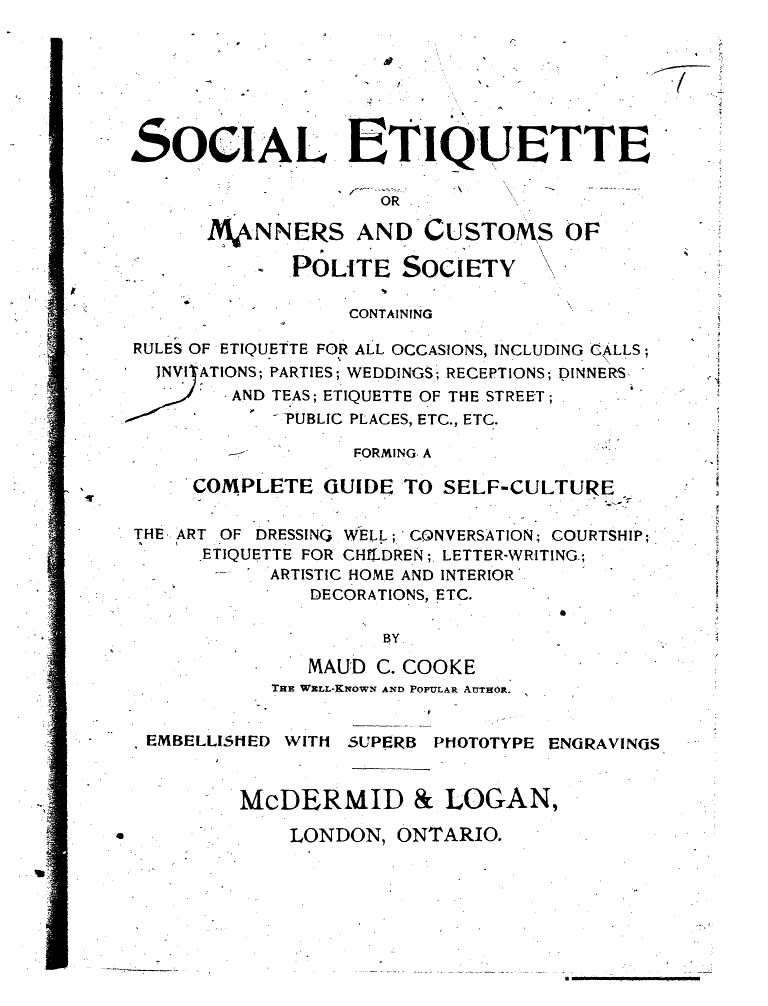This first appeared in the Montclarion in November 1999.

There is a delightful book in the Oakland History Room called Social Etiquette, or Manners and Customs of Polite Society.
Written in 1896 by Maud C. Cooke, the book was put out by an Oakland publisher, Occidental Publishing Co. The book provides everything from placement of finger bowls to how to properly court a lover.
In a section entitled, “Errors of Lovemaking,” Cooke discloses that a woman who has captured a man’s heart “can get out of him, and do with him, anything possible she pleases. The charming and fascinating power of serpents over birds is as nothing compared with that a woman can wield over a man.” Not that I’ve ever seen snakes hypnotizing birds, but it’s an effective metaphor.
Cooke even provides sample text for a marriage proposal: “I crave to make you my wife; to live with and for you, and proffer you my whole being, with honest, assiduous toil, fidelity to business, what talents I possess, and all I can do to contribute to your creature comforts. May I enshrine you as the queen of my life?” it reads in part.
How could any woman resist this mammoth, eight-paragraph flowery proposal? She’d have to marry the man in pure admiration of his ability to memorize such lengthy text.
Of course, Cooke provides a template acceptance speech, four paragraphs long, containing the newly affianced woman’s amusing observation, “Thank Heaven that the matter is settled.”
At the turn of the century, grapes were eaten in a very delicate manner. The pulp was squeezed into the mouth and the skin of the grape laid on one side of the plate. Another alimentary oddity was a party called a “Chocolataire,” in which every food and beverage contained chocolate.
As the bicycle was relatively new at the time of the book’s writing, there is an entire chapter devoted to bicycle etiquette. A man was expected to assist a woman in mounting her bike, by holding her wheel. As she began to cycle away on the “machine,” she would do so very slowly, to give him time to mount his and catch up.
He was also to help her dismount, although in the meantime she was to “assist herself as much as possible.” To “furnish” a bike, it was de rigueur to have a clock and a bell, a luggage carrier and cyclometer.
Know anything about calling cards? This very mysterious process still remains veiled in shadows for me after reading about their use.
When a visitor went to see someone and that person was not at home, the visitor would leave a card with his name on it, to show that he had been there.
However, sometimes cards came by mail, apparently simply to announce one’s presence. In fact, if a person had come physically to the house, he would fold a corner of the card to denote that fact. The card was folded down the middle if the entire family had accompanied the person named on the card. Further, separate cards would be left for the man and the woman of the house. Inexplicably, the man of the house received two cards, as if he would need one for each eyeball.
 Of course, correspondence in this pre-telephone era was a matter of extreme importance. Woman are granted the privilege of using “very faintly perfumed paper,” and Cooke suggests they always use the same fragrance, so “correspondents could tell her missives with closed eyes.”
Of course, correspondence in this pre-telephone era was a matter of extreme importance. Woman are granted the privilege of using “very faintly perfumed paper,” and Cooke suggests they always use the same fragrance, so “correspondents could tell her missives with closed eyes.”
Diagrams are given of correct and incorrect ways to hold the pen, as well as how to sit while writing. Interestingly, Cooke advises burning all letters after answering them, but simultaneously warns to date all correspondence, as “events and proof of the greatest importance have hung upon the date of a single letter,” which would suppose that the letter was kept.
One last snippet of information: hangnails used to be called “agnails,” and cuticles were called “scarf-skin.”
Note: When I went back to the Oakland History Room to look for this book I wrote about back in 1999, it had subsequently disappeared from the shelves. These images were found on canadiana.org, a website that has scanned every page of the book. It’s a good thing the book exists electronically since its paper and glue counterpart has gone missing.

Pingback: Erika Mailman » Montclarion Columns